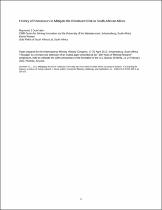JavaScript is disabled for your browser. Some features of this site may not work without it.
- ResearchSpace
- →
- Research Publications/Outputs
- →
- Conference Publications
- →
- View Item
| dc.contributor.author |
Durrheim, RJ

|
|
| dc.contributor.author |
Riemer, KL

|
|
| dc.date.accessioned | 2012-07-09T14:33:32Z | |
| dc.date.available | 2012-07-09T14:33:32Z | |
| dc.date.issued | 2012-04 | |
| dc.identifier.citation | Durrheim, RJ and Riemer, KL. History of endeavours to mitigate the rockburst risk in South African mines. International Mining History Congress, Johannesburg, South Africa, 17-20 April 2012 | en_US |
| dc.identifier.uri | http://hdl.handle.net/10204/5990 | |
| dc.description | International Mining History Congress, Johannesburg, South Africa, 17-20 April 2012. | en_US |
| dc.description.abstract | Gold was discovered near present-day Johannesburg in 1886. Mining-induced seismicity was first encountered in the early 1900s when extensive stopes reached depths of several hundred meters. The State appointed committees in 1908, 1915, 1924, 1964 and 2005 to investigate the cause of the tremors and to recommend mitigating measures. The 1908 Committee recommended that seismographs be installed and scientific observations began in 1910. The main mitigating strategies that were developed were: (i) mining layouts and regional support systems (e.g. strike and dip pillar systems, backfill) that controlled the release of seismic energy through the geometry and sequence of mining; (ii) local support units and systems (e.g. rapid-yielding hydraulic props, pre-stressed elongates, yielding tendons) that limited rockburst damage; and (iii) seismic monitoring technology that continually assesses the hazard and the effectiveness of measures to control seismic activity (e.g. through the rate of mining). Implementation of these technologies, together with improvements in training, work organization and regulation, have reduced fatality rates and made it possible to mine successfully at depths of 4 kilometers. | en_US |
| dc.language.iso | en | en_US |
| dc.relation.ispartofseries | Workflow;9040 | |
| dc.subject | South African mines | en_US |
| dc.subject | Rockburst risks | en_US |
| dc.subject | South African mining | en_US |
| dc.subject | South African mining history | en_US |
| dc.subject | Mining-induced seismicity | en_US |
| dc.title | History of endeavours to mitigate the rockburst risk in South African mines | en_US |
| dc.type | Conference Presentation | en_US |
| dc.identifier.apacitation | Durrheim, R., & Riemer, K. (2012). History of endeavours to mitigate the rockburst risk in South African mines. http://hdl.handle.net/10204/5990 | en_ZA |
| dc.identifier.chicagocitation | Durrheim, RJ, and KL Riemer. "History of endeavours to mitigate the rockburst risk in South African mines." (2012): http://hdl.handle.net/10204/5990 | en_ZA |
| dc.identifier.vancouvercitation | Durrheim R, Riemer K, History of endeavours to mitigate the rockburst risk in South African mines; 2012. http://hdl.handle.net/10204/5990 . | en_ZA |
| dc.identifier.ris | TY - Conference Presentation AU - Durrheim, RJ AU - Riemer, KL AB - Gold was discovered near present-day Johannesburg in 1886. Mining-induced seismicity was first encountered in the early 1900s when extensive stopes reached depths of several hundred meters. The State appointed committees in 1908, 1915, 1924, 1964 and 2005 to investigate the cause of the tremors and to recommend mitigating measures. The 1908 Committee recommended that seismographs be installed and scientific observations began in 1910. The main mitigating strategies that were developed were: (i) mining layouts and regional support systems (e.g. strike and dip pillar systems, backfill) that controlled the release of seismic energy through the geometry and sequence of mining; (ii) local support units and systems (e.g. rapid-yielding hydraulic props, pre-stressed elongates, yielding tendons) that limited rockburst damage; and (iii) seismic monitoring technology that continually assesses the hazard and the effectiveness of measures to control seismic activity (e.g. through the rate of mining). Implementation of these technologies, together with improvements in training, work organization and regulation, have reduced fatality rates and made it possible to mine successfully at depths of 4 kilometers. DA - 2012-04 DB - ResearchSpace DP - CSIR KW - South African mines KW - Rockburst risks KW - South African mining KW - South African mining history KW - Mining-induced seismicity LK - https://researchspace.csir.co.za PY - 2012 T1 - History of endeavours to mitigate the rockburst risk in South African mines TI - History of endeavours to mitigate the rockburst risk in South African mines UR - http://hdl.handle.net/10204/5990 ER - | en_ZA |






